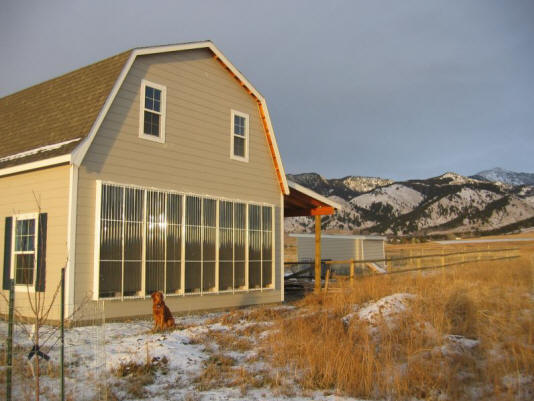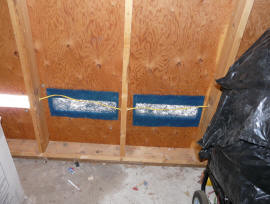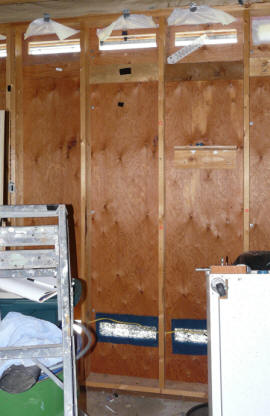
Search
The Renewable Energy site for Do-It-Yourselfers
Effect of Air
Filter on Thermosyphon Collector Air Flow
| This
solar air heating collector that I use to heat my shop has no
obstruction in the inlet vent. Mike is thinking about doing one of
these collectors, but would want to have an air filter in the inlet to
keep dust out of the collector, and is wondering if the air resistance
of the filter will have an impact on air flow because of the extra
resistance of the filter. This seems like a good question, and I did
this test to get some idea how much effect adding an air filter in the
inlet vent has on flow and on heat output.
 |
|
I used some filter material that I
had around, and just cut it out a bit bigger than the vent opening, and stapled
it to the sheathing that the vent is cut into.
Click on pictures for full size
|

The filter material used. |

Filter material stapled over the
inlet vents for one bay. |
|

Air enters bottom vents (with filters)
rises up through collector, and
exits the top vents. Two identical bays, one
one with vent filters and one without were
compared. |
I measured the exit vent airflow velocity on the
collector bay with the filter material over the inlets and compared this to the
measurements for the adjacent (identical) collector bay without the filter.
The average of several readings over about an hour
ending around solar noon:
| |
With Inlet Air Filters |
With inlet vent open |
|
Vent velocity |
60 fpm |
90 fpm |
|
Temperature rise |
32F |
22F |
Ambient conditions were full sun with air temperature around 82F, July 6,
2009
So, the inlet filter cuts the air velocity by about
1/3 under these conditions. But, there is some compensating increase in
temperature rise through the collector.
The heat output of the collector is proportional to
(Vent Velocity)*(Temperature Rise). If you multiply these out, the with
and without filter actually come out nearly tied. So, under these
conditions, the filters decrease vent velocity, but don't decrease heat output.
I think that in the winter the results may be
somewhat worse for the collector bay with filters because the ambient
temperature would be mush lower, and the heat loss from the collector bay out
through the glazing would be larger -- this would reduce the temperature rise
for the filtered collector.
These were not ideal conditions to do the testing.
In mid summer, the sun is quite high, and this reduces the gain of the
collectors a lot -- mid-winter air velocities are in the 140 fpm area. I
did not have my Dwyer Vaneometer to measure air velocity and had to use the
Kestral wind meter -- it only measures to the nearest 10 fpm, and 60 fpm is
about at the bottom of its range. So, while I think the numbers give a
rough idea what's going on, take them with a grain of salt. I left the
filters stapled in place, and will repeat the test under mid winter conditions.
While I hate to do anything to increase flow
resistance through a thermosyphon collector, it appears that a low resistance
air filter might be used in the inlet without impacting performance too much.
The filter should have as low a resistance as possible, and it would be a good
idea to make the inlet vents larger to increase the flow area.
I should mention that there is very little dust in
the collector bays on mine after 5 years, but I do not normally do dusty
activities in this shop.
Gary July 6, 2009

